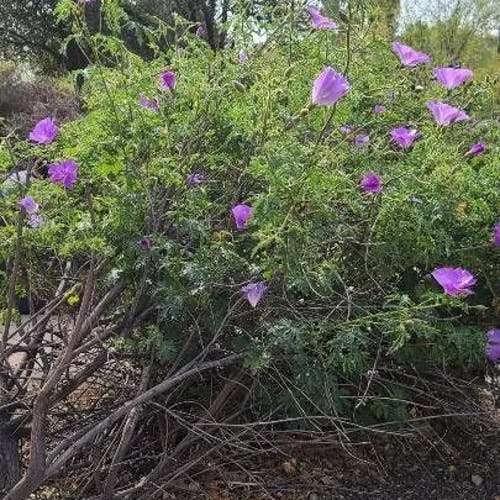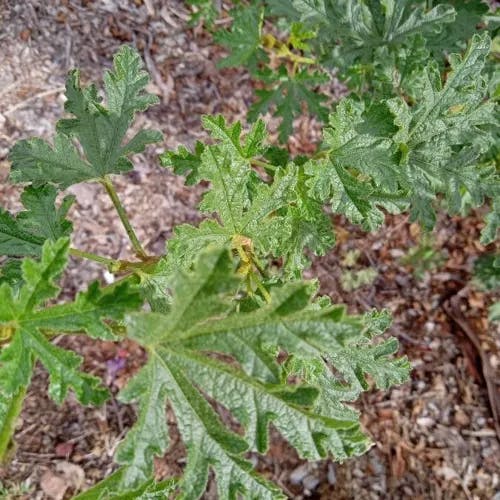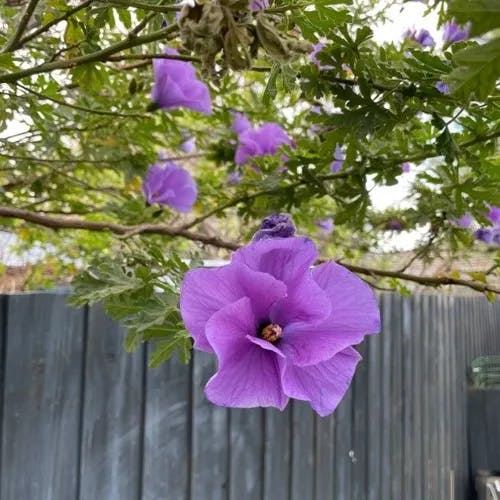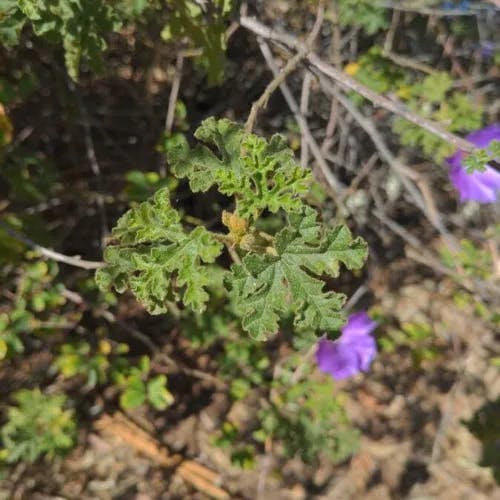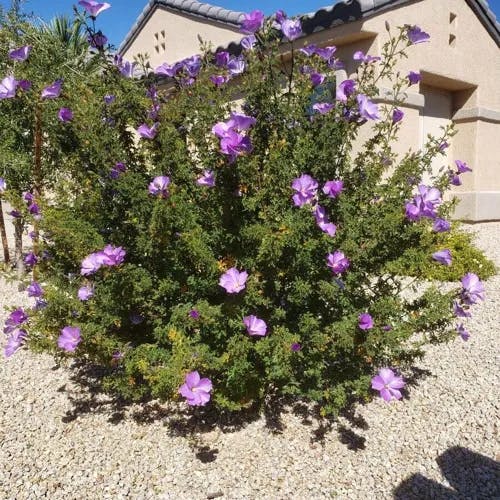Sunlight absorbs Alyogyne huegelii, sprouting perennial lilac shrubs endemic to arid Australian coasts. Lavender blooms trumpet five fused petals, charming violet hues, averaging ten diameter centimeters. Species symbolizes pulchritude, poise, refinement. Durable, drought-hardy qualities render well-suited xeric climates. Varieties exhibit distinctive flower pigments, growth habits. Though capsule fruit emerges, cultivated primarily for ornamental blossoms. Adds pop vivid color, curb appeal gardens.
Lilac-hibiscus
- Scientific name
- Alyogyne huegelii
Basic Information
- Malvaceae Family Alyogyne Genus Lilac-hibiscus Species
- Malvaceae > Alyogyne > Alyogyne huegelii
- 83%
- The Completeness of This Encyclopedia
Please help us complete the encyclopedia, Terrarium is a encyclopedia service to be completed with everyone in the world. Currently, this page is 83% complete. For more information on how to contribute, please click here.
- Shrub
- Height
- 300cm ~
- Flower Color
- Leaf Color
- Anthesis
- spring, summer
- Sunlight Exposure
Full Sun Long hours of sunlight from morning to afternoon Partial Shade A location in the shade of a tree or where either the morning or afternoon is shaded Full Shade A place where there is no direct sunlight
- Full Sun
- Hardiness Zones
This is an indicator to know to which zone each plant can winter. Knowing the zone of each plant gives you an idea of the cold temperature resistance when grown in the ground without a roof. 2: -42.7 to -40.0 3: -39.9 to -34.4 4: -34.3 to -28.9 5: -28.8 to -23.3 6: -23.2 to -17.8 7: -17.7 to -12.2 8: -12.1 to -6.7 9: -6.6 to -1.1 10: -1.0 to 4.4 11: 4.5 to 10.0
- 9
- Cold resistance
- Fair
- Heat resistance
- Good
- Habitat of origin
- Australia
- Growth Rate
- Normal
What is Lilac-hibiscus (Alyogyne huegelii)?
What is Lilac-hibiscus (Alyogyne huegelii)
Flower meaning
Lilac-hibiscus does not have an accepted flower meaning in America. This lovely shrub's blossoms come in many colors. Their hues range from purplish-blue to rosy-pink. Lilac-hibiscus's flowers add beauty wherever they grow. This hardy plant thrives outdoors in warm areas. It does well indoors too. Lilac-hibiscus blooms spring through fall. Give it sun and well-drained soil. Water when the top inch of soil dries out. Propagate with tip cuttings. Prune as needed to shape the plant. Lilac-hibiscus is versatile. Use it as a hedge, screen or accent plant. Let its big, bright blooms brighten your garden.
Calendar of Lilac-hibiscus (Alyogyne huegelii)
Calendar
The shrub Alyogyne huegelii plants in warmth position give a floriferous spectacle of shining plum blossoms during the hot summer until the frost in springtime or early summer. Vigorous blooming lasts weeks if the soil drains well with fertilizing and hydrating. After blooming finishes, pruning motivates new shoots and more flowers next season. The perennial hibiscus-lilac prefers maximum sunlight. It is indigenous to Australia but an ornamental in America. Peak blooming occurs in July and August but begins in late spring or early summer based on climate. The scientific name for the vibrant, long-flowering bush is Lilac-hibiscus.
How to grow Lilac-hibiscus (Alyogyne huegelii)
Watering
Per season-dependent ramifications of progressing growth, the Lilac—hibiscus becomes suitably simulated by liquid sustenance. During flourishing cycles characterizing vernal and summer interims, the blossom necessitates adequate moistening for terrane saturation conservation. Saturate profoundly singular or doubly weekly until infiltration of root regions happens. Despite extensive variation contingent on specimen and earth constitution, supplying 1-1.5 linear units per hebdomad suffices generally. Contrastingly, underneath torpid cycles of autumn and winter, lessened moistening frequency becomes requisite. Permitting fractional desiccation of terra between irrigation averts overhydration and subsequent rhizome putrefaction. Hydrating singularly per bimensual or trimensual interlude should satisfy this torpidity. Exact terrane hydration surveying becomes critical for determining irrigation periodicity. Utilize hydrometers or manually ascertain dirt moisture by digitation to second interknuckle depth. If xeric sensation happens at such depths, rehydration becomes necessary.
Soil and Fertilizer
The Hibiscus syriacus, which likes loamy dirt containing a lot of organic matter likes a soil pH between 6 and 7.5, with somewhat wet but not waterlogged dirt. Twice a year feed it fertilizer containing equal parts nitrogen, phosphate, and potassium for best growth. While fertilizing, scatter 1⁄4 to 1⁄2 cup of the fertilizer evenly on the ground around the plant in early spring when just getting new growth. Another feeding can happen each month during the growing period to keep the flowers blooming but too much fertilizer is not good and will inhibit blossoms. Regularly checking the soil pH and nutrients is wise, and adjustments made as needed for ideal lilac-hibiscus soil conditions.
Sunlight and Place
The lilac hibiscus, also known as Hibiscus syriacus, thrives with abundant daylight. Ample sunlight throughout the daylight hours promotes thriving growth and plentiful flowering. It endures both cold and heat well, making it suitable for diverse climates. Winter weather as frigid as -10°F (-23°C) is within its cold tolerance. Hot summer weather up to 100°F (38°C) is within its heat tolerance. Its optimal temperature range is 65°F to 85°F (18°C to 29°C). To protect its roots from winter's freezing temperatures, apply mulch around the base in winter. Regular summer watering maintains its moisture when it's hot. Lilac hibiscus requires at least six hours of direct sunlight daily to flourish fully. Placing it where ample daylight reaches it throughout the day is crucial. In summary, lilac hibiscus withstands diverse temperatures but needs abundant daylight. With ample sunlight, proper cold and heat care, and optimal placement, it will thrive and flower abundantly.
Advanced Information of Lilac-hibiscus (Alyogyne huegelii)
Pruning
Pruning the Alyogyne huegelii has advantages. It will remain fit and harbor a robust growth if cut periodically. Lopping away the withered or ruined appendages, encouraging circulation, and promoting brand-new shoots are the goals of trimming. Before increase begins, belated winter or ancient spring are prime times for pruning. First discard any decayed or infected stems by cutting to fit wood. For symmetry and proper measurement, selectively cut offshoots. Sever cleanly at a minor slant just over a swelling or branching. Refrain from trimming too adjacent the trunk, as it can induce retrogression. Later, get rid of all clippings to halt maladies from spreading. Additionally, use a counterpoised fertilizer to boost shoots and welfare. The Alyogyne huegelii will boom and generate plentiful inflorescences through regular pruning.
Planting and Harvest
The scientific name of Alyogyne huegelii, a pot or garden plant, is Lilac-hibiscus. Adding holes for water drainage to the bottom of its container and filling it with potting mix that lets water pass through easily is important when potting Lilac-hibiscus. Carefully take the plant out of its nursery container without harming the roots. Put the plant in the center of the pot and add more potting mix around it, making sure the top of the plant is level with the top of the soil. After potting, water the plant thoroughly and place it where it will get bright but indirect sunlight. If planting Lilac-hibiscus in the ground, pick a spot with soil that drains well and gets full sun. Dig a hole two times wider and deeper than the plant's root ball. Carefully remove the plant from its nursery pot and put it in the hole, checking that the top of the root ball lines up with the ground. Fill in the hole with soil, packing it lightly around the plant. Water the plant well after planting and keep watering it regularly, especially during dry times. Repotting Lilac-hibiscus should happen every 2-3 years or whenever the plant is too big for its current pot. Choose a slightly bigger pot and follow the same steps for potting mentioned earlier. Poor care can make the plant decline. Giving adequate water, sunlight, and fertilizer on a regular schedule is important for the health and vigor of Lilac-hibiscus. Pruning can also be done to maintain its shape and encourage bushier growth.
Propagation
Lilac-hibiscus possesses various propagation methods. Propagating through sowing mature seeds gathered from the plant in well-draining potting mix requires keeping soil moist while providing indirect sunlight. Propagating through division means carefully separating plant sections with roots attached then planting these in individual pots with well-draining soil and regular watering. Taking four-six inch stem cuttings from plant, removing lower leaves, then dipping cut end in rooting hormone before planting in pot with well-draining soil while keeping in warm, humid environment propagates through cuttings. Propagating through leaf cuttings involves taking healthy leaves, cutting into smaller sections, then placing into pot with moist soil and consistent moisture and indirect light. Harvesting is unnecessary for the propagation methods described.
Pests and Diseases
The Lilac-hibiscus, scientifically called Syriacus hibiscus, can suffer from many bugs and illnesses. One insect that harms this flower is the aphid. Aphids are tiny bugs that eat the juice of the flower, stopping growth and twisting leaves. To stop aphids, look at the flower often, and if found, use soapy water or oils to control them. Another bug, the whitefly, also troubles the Lilac-hibiscus. Whiteflies are small, winged bugs that sip juice from leaves. This makes leaves turn yellow, wilt, and fall. To stop whiteflies, keep the plant clean by removing any bothered leaves. Also use sticky traps to catch adult whiteflies. The Lilac-hibiscus can also get fungal diseases like powdery mildew. Powdery mildew seems like a white, powdery coat on leaves, stems, and flowers. It can twist leaves, turn them yellow, and make them fall early. To prevent powdery mildew, allow good air flow around the flower. Also avoid wetting from above and use antifungals if needed. Another disease, leaf spot, can also affect the Lilac-hibiscus. Leaf spot comes from different funguses and looks like dark, round spots on leaves. It can make leaves fall and weaken the flower. To prevent leaf spot, avoid wetting from above, remove troubled leaves, and use antifungals if required. The Lilac-hibiscus can wither from drought, overwatering, poor nutrients, or root rot. Proper water, drainage, and fertilizer will prevent withering.
Habitat of Lilac-hibiscus (Alyogyne huegelii)
Habitat
Toxicity of Lilac-hibiscus (Alyogyne huegelii)
Health Benefits
- edible
- Inedible
- Toxic
- No toxicity
NO DATA
Toxic for dogs and cats
NO DATA
Q&A of Lilac-hibiscus (Alyogyne huegelii)
- Is there a recommended way to choose Alyogyne huegelii?
The plant formerly identified as Lilac-hibiscus has been reclassified under the scientific name Alyogyne huegelii. This flowering plant can propagate from seeds or young plants. Selecting the appropriate cultivar involves evaluating desired inflorescence pigmentation and mature stature. Flower colors include azure for 'Blue Hibiscus', ivory for 'White Hibiscus', and crimson for 'Pink Hibiscus.' The 'Compact' cultivar reaches reduced ultimate heights appropriate for confined cultivation areas. Alternatively, the 'Tall' cultivar can attain approximately 2 meters for accentuating expansive gardens. When acquiring seeds, evaluate expiration information and storage conditions. For juvenile plants, inspect for robust stems and verdant leaves. Avoid specimens displaying chlorotic or flaccid foliage, possibly indicating suboptimal health. By thoroughly researching cultivars, propagation materials, and plant health, gardeners can incorporate Alyogyne huegelii as an ornamental landscape specimen.
- Is Hibiscus Rosa Sinensis a Perennial Plant?
The longevity of flora differs between species. For example, Hibiscus Rosa Sinensis can carry its beautiful flowers over numerous seasons. Meanwhile, Alyogyne huegelii sprouts its striking lilac blooms annually in its endemic Australia. Though varied in traits, both perennials can persist for over two years.
